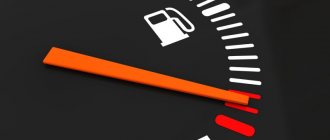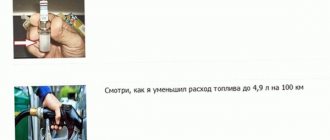The fuel consumption of the VAZ 2107 per 100 km depends on many factors. These include the following: vehicle speed, engine type and fuel supply system. What is the fuel consumption of a VAZ 2107 with a carburetor? According to documents for this model of car, the average fuel consumption on the highway is 6.8 liters, if the speed is about 90 km/h. P When driving in city mode, this figure increases significantly - up to 9.6 liters.
What you need to know to reduce fuel consumption
Checking the air damper in the carburetor
Higher fuel consumption on a VAZ 2107 with a carburetor engine occurs if the air damper is not fully open. What is its correct position? Surely, an experienced driver knows that when the engine in the car is running, the choke in the carburetor must be in a vertical position. The choke handle must be fully extended towards you. Fuel consumption at idle speed in the VAZ 2107 can be reduced by specially setting the carburetor air damper to some extent. But such manipulation is not effective enough.
| Engine | Consumption (highway) | Consumption (city) | Consumption (mixed cycle) |
| 1.3 l 4-mech (gasoline) | 7.8 l/100 km | 11.5 l/100 km | 10.5 l/100 km |
| 1.4 l 5-mech (gasoline) | — | 9 l/100 km | — |
| 1.5 l 5-mech (gasoline) | 5.2 l/100 km | 8.9 l/100 km | 7 l/100 km |
| 1.6 l 5-mech (gasoline) | — | 8.5 l/100 km | — |
| 1.3 l 5-mech (gasoline) | 9.5 l/100 km | 12.5 l/100 km | 11 l/100 km |
The reasons for the high fuel consumption on VAZ 2107, the carburetor of which is in a faulty condition, speak for themselves. Young drivers do not always take the time to thoroughly check their car, and this can lead to negative consequences. Other factors of uneconomical fuel consumption may include:
- incorrect speedometer readings;
- malfunction of the device that measures the level of gasoline in the tank;
- driver's driving style.
Is it possible to reduce injector consumption?
Now it’s worth talking about how to reduce fuel consumption on an injection engine. The surest way is to change the microcontroller firmware. At the same time, a new fuel map is recorded according to which the engine operates. The content of air and gasoline changes, therefore, there is a loss of power. But you get a slight advantage. As a result of such manipulations on the VAZ 2107 injector, fuel consumption decreases. True, the maximum speed, power and throttle response of the car also become less. When choosing firmware, car owners are guided by the average indicators shown in the table. For comparison, data is presented for a similar engine with a carburetor injection system.
Checking the fuel jet
Also, the reason for the high consumption of gasoline on a VAZ can be the fuel nozzle if its holder is not tightly enclosed. Because of this, during different engine operating modes, much more fuel enters the cylinders than required by the norm. To avoid this situation, check the tightness of the holder. You cannot tighten it too much, but even if it is not tightened completely, this will lead to the fact that the holder can randomly turn out while the machine engine is running. The reason for the overconsumption is that the diameter of the jets is too large or they are dirty.
Measures to reduce fuel consumption
As mentioned above, the driver can himself eliminate some of the factors causing increased fuel consumption.
Filling with gasoline with the required octane number
The octane number measures how well gasoline resists knocking. The higher the octane number, the more the gasoline can be compressed in the cylinder, and the later it will explode. Therefore, if the driver wants to get as much power as possible from the engine, the engine must compress the gasoline as hard as possible.
When choosing gasoline, the owner of a VAZ 2107 must remember the general rule: if you fill the car with gasoline with an octane rating lower than the calculated one, fuel consumption will increase. And if you fill in gasoline with a quantity higher than the calculated value, then the consumption will not decrease (and in some cases, it will also increase). That is, if the instructions for the “seven” say that its engine is designed for AI93 gasoline, then when filling with AI92, fuel consumption will increase. But if the engine is designed for AI92, and the driver fills it with AI93 or AI95, then there will be no tangible advantages from this. Moreover, consumption may increase if the gasoline being poured turns out to be of poor quality, which is observed quite often today.
About engine overhaul
Engine overhaul is a radical and very expensive procedure. In the case of the VAZ 2107, such a procedure is not always justified, since for the money spent on a major overhaul of the engine, it is quite possible to buy another “seven” in good condition (possibly with a small surcharge). If the driver nevertheless decides to carry out a major overhaul due to the increased appetite of the engine, then such repairs usually come down to replacing the piston rings and grinding in the valves, as already mentioned above.
Not everyone can carry out such repairs in a garage, since this requires a lot of special equipment and instruments (to accurately measure and adjust compression in the cylinders, for example). Therefore, there is only one solution: take the car to a service center and negotiate a price with qualified auto mechanics.
About warming up the engine
Warming up the engine is another simple measure a driver can take to reduce fuel consumption. This is especially true during the cold season. When starting to warm up the engine, the driver must remember: the carburetor “seven” will have to warm up longer than the injection one. The fact is that a carburetor engine cannot be operated normally until the idle speed stabilizes.
Warming up the carburetor "seven"
Here is the warm-up sequence for early VAZ 2107 models.
- The engine starts, and the air damper must be completely closed.
- After this, the damper opens little by little, while ensuring that the speed stability does not decrease.
- Now the driver has two options. Option one: start moving and do not wait until the engine temperature exceeds 50°C.
- Option two. Gradually reduce the suction until the engine runs stably without suction and only then start moving. In this case, the warm-up time will increase, but only by two to three minutes.
Video: warming up a “classic” in the cold
Excessive fuel consumption on the injector
Owners of new modified VAZ cars with a single electronic control unit may encounter excessive consumption of gasoline at the injector. One of the reasons may be incorrect pressure in the fuel system. Recheck the car's engine management system; there may be a malfunction in its operation.
Also, one of the key problems with fuel consumption can be the failure of an injector or temperature or oxygen sensor. The fuel consumption of a Lada 2107 per 100 km with an injector (engine volume 1.5 liters) in the city in winter should be 9.5-13 liters, and in summer – 7.5-8.5 liters.
WE CONTROL FUEL CONSUMPTION ON THE VAZ 2107 INDEPENDENTLY
Fuel consumption is the most important characteristic of a vehicle. The efficiency of an engine is largely determined by the amount of fuel it consumes. This rule is true for all passenger cars, and the VAZ 2107 is no exception. A responsible driver carefully monitors how much gasoline his “Seven” consumes. In certain situations, the amount of gasoline consumed can increase sharply. Let's figure out what these situations are and how to eliminate them.
FUEL CONSUMPTION RATES FOR VAZ 2107
As you know, the VAZ 2107 was equipped with different engines at different times.
Consequently, fuel consumption rates also changed. This is what it looked like:
CLIMATE AND CONSUMPTION RATES
The climate in which the machine is operated is the most important factor affecting fuel consumption. It is impossible not to mention this factor. In winter in the southern regions of our country, average fuel consumption can vary from 8.9 to 9.1 liters per 100 km. In the central regions, this figure varies from 9.3 to 9.5 liters per 100 km. Finally, in the northern regions, winter fuel consumption can reach 10 liters or more per 100 km.
AGE OF THE CAR
The age of the car is another factor that many car enthusiasts often overlook. It’s simple: the older your “seven” is, the greater its “appetite”. For example, for cars older than five years with a mileage of more than 100 thousand km, the average fuel consumption is 8.9 liters per 100 km. And if the car is more than eight years old and its mileage exceeds 150 thousand km, then such a car will consume an average of 9.3 liters per 100 km.
OTHER FACTORS AFFECTING FUEL CONSUMPTION
In addition to climatic conditions and the age of the car, many other factors affect fuel consumption. It is not possible to list them all in one short article, so we will focus only on the most basic ones, the influence of which the driver can reduce.
What needs to be done to optimize fuel consumption
Try to drive without sudden braking or sudden acceleration. To ensure that the actual consumption of the VAZ 2107 does not exceed the norm, replace the use of mineral motor oil with synthetic one.
Check your vehicle regularly and replace the air filter if necessary.
Gasoline consumption 2107 per 100 km (and regardless of the kilometers traveled) at normal vehicle speed also depends on the quality of the fuel, so try to purchase it at large network gas stations. The saving of fuel and your financial resources depends on the technical condition of the car.
VAZ 2107 1.6 injector
The Lada 2107 version with an injection engine was produced from 2002 to 2012 and gained quite a lot of popularity in the market. Technical data: maximum speed – 150-155 km/h, acceleration to 100 km/h in 15-16 seconds, engine power – 74 hp, average fuel consumption, as in previous trim levels, – 8.5 liters (9.7- 9.8 liters in the city and 6.8-7.3 liters on the highway).
Reviews about fuel consumption
- Sergey, Makhachkala. My Lada has already outlived its usefulness. I bought a new one in 2002 with an injector, didn’t regret it at all, but it’s still running. Paint it, clean it, repair it, and it will be as good as new. The engine works like a clock, eating the same 10-12 liters in the city and 10 on the highway as at the very beginning of operation.
- Nikolay, Derbent. For a novice driver, there is no better car “simulator”; sit down and go ahead and learn the basics of driving. I fill my VAZ with whatever is at hand, because this car does not test the quality of gasoline and oil. The fuel consumption is not surprising at all - the manufacturers said 8.5 liters in a mixed mixture and it is so. In the city around 10 liters in summer and 12 in winter.
- Dmitry, Belgorod. This car has already become a family heirloom. Grandfather bought a new one in 2002, dad got a Lada in 2010, and now I drive a taxi. An excellent car for family outings or fishing - it will fit anywhere and in any conditions. Consumption is standard for this model - 9 liters in the combined cycle. In the city I get 12 liters, since I often go out for short distances.
- Yuri, Pskov. VAZ (Lada) 2107, injector, model 2005. I have never seen a cooler gearbox than on the Lada. Clear switching, precise engine operation, clear limits on gasoline consumption. A full tank takes 340-360 liters, depending on the time of year. The average consumption on the highway is 7.5 liters, and in the city it turns out to be 11 or less.
- Anna, Kemerovo. For a long time I used it for trips to buy goods and I had no problems with this machine. I had to change it to something newer, but I remembered the Lada 2107 forever - a trouble-free engine and a stable average consumption of 9 liters in the summer. In cold weather, the stove was a lifesaver, even though it took 11 liters of gasoline.
Other cars: Chery Indys fuel consumption reviews











